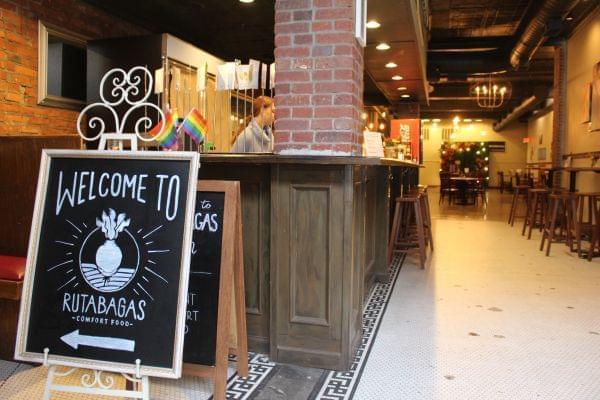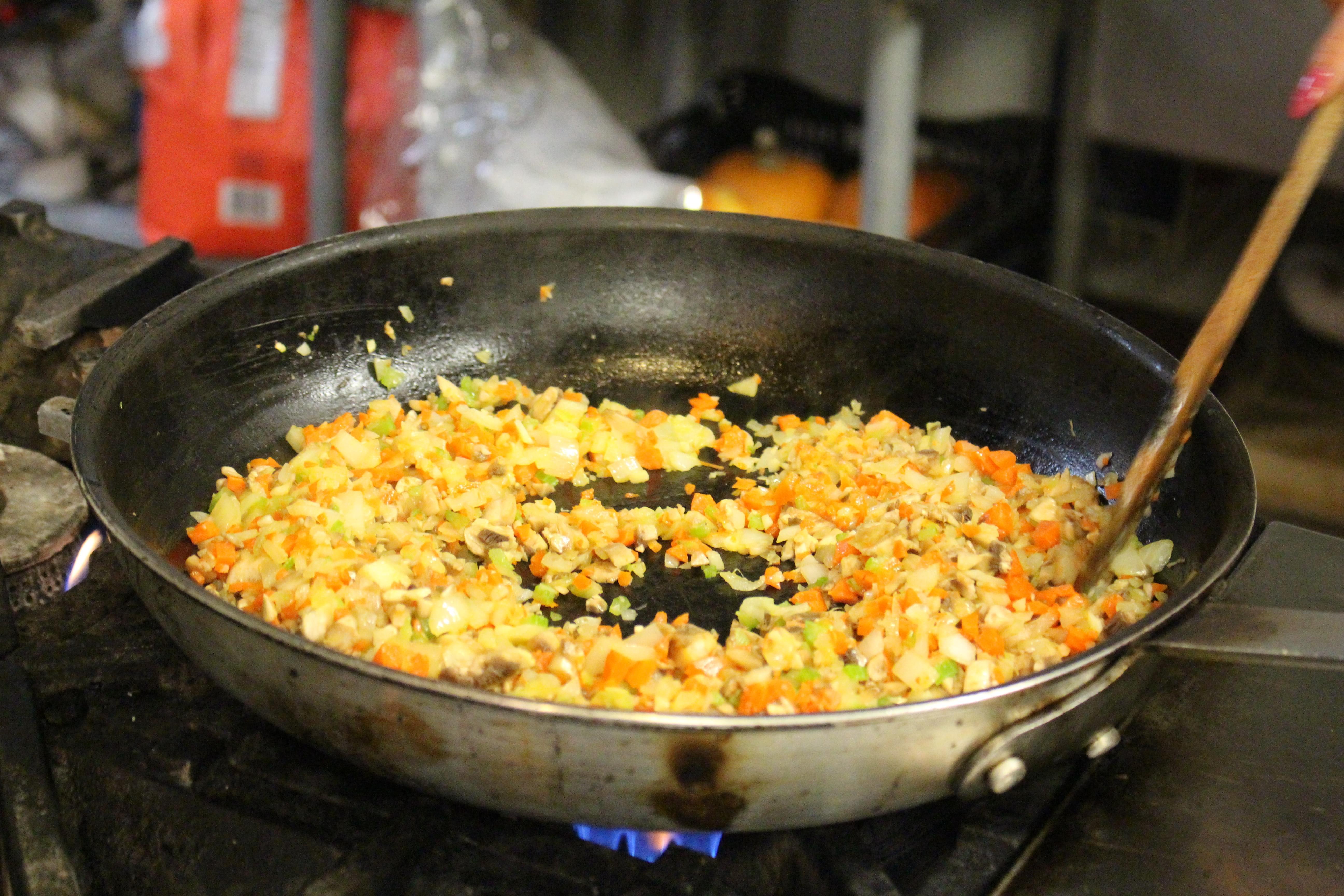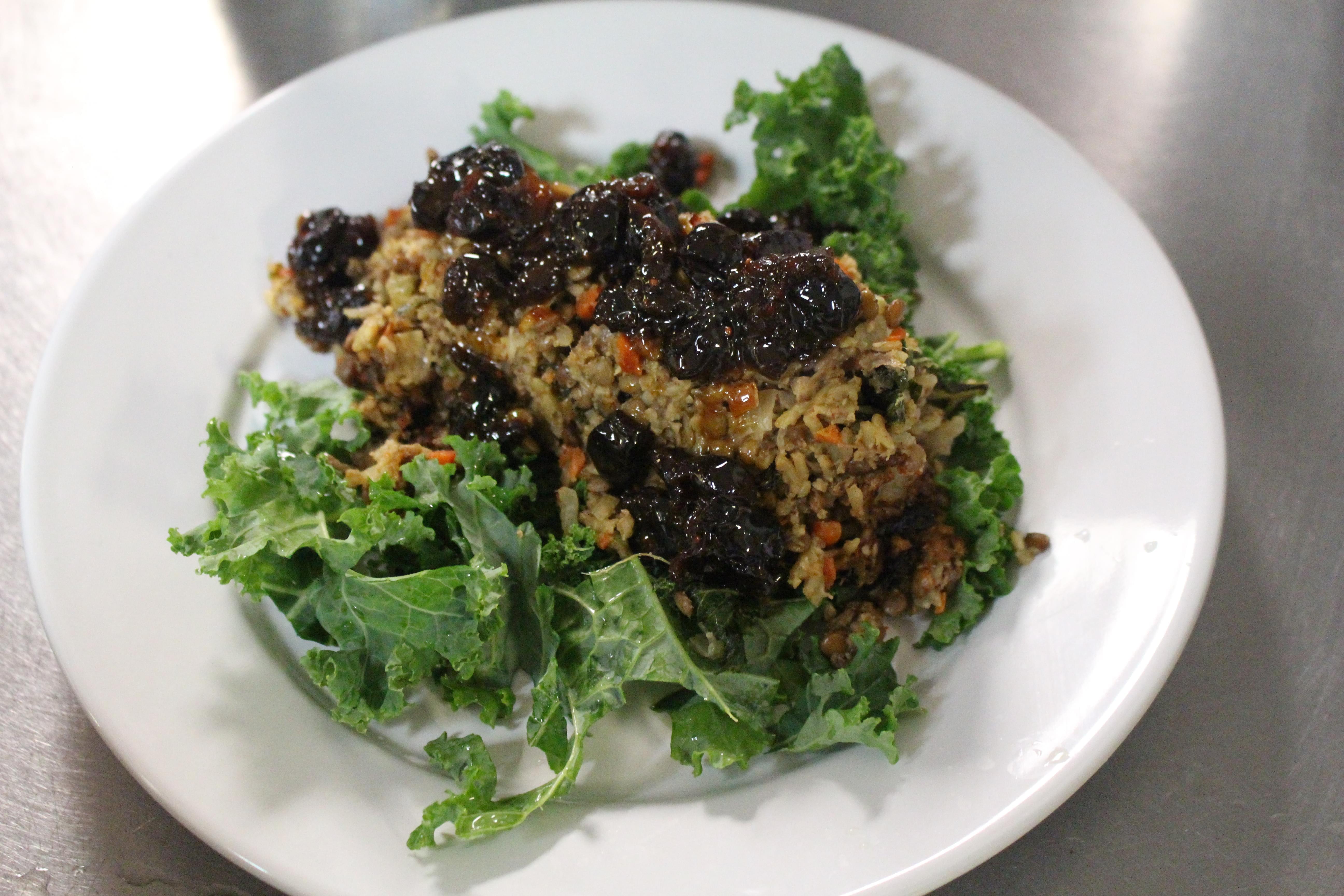For Plant-Based Eaters, Veganizing The Holiday Table Is Easier Than Ever

Rutabaga's Comfort Food in Lincoln, Nebraska. Christina Stella/Harvest Public Media
The holiday season is officially upon us, and so are its classic dishes. For some home cooks who are vegan or vegetarian, Thanksgiving can be a time to flex their culinary creativity, and make the well-loved new.
The sky is dark and cloudy, but inside Rutabaga’s Comfort Food in downtown Lincoln, the light is warm, and it smells like Thanksgiving.
Sara Brown and her kitchen team are bracing for the lunch rush. Though the restaurant opened just two months ago, the dining room already tends to be busy by noon.
“People think all vegans eat are, like, bean patties, and that's just simply not true,” she said.
Brown has spent a lot of time figuring out how to merge a plant-based mission with dishes that feel familiar and decadent. That includes veganizing the Thanksgiving table this year.
Brown and her team are offering a Thanksgiving catering menu that customers can order ahead of time and reheat. They’ll fill over thirty orders for the classics and then some, like the cranberry-lentil loaf.
The dish starts with the all-star aromatic base of Thanksgiving: a classic mirepoix mix of chopped onion, celery, and carrot. Cooking vegetables or “sweating” them helps to release their natural sugars, which deepens and concentrates flavor.

Sara Brown sautees chopped onion, celery and carrots to make her cranberry-lentil loaf.
After a few minutes, Brown mixes in some kale and cooks the leaves down to reduce their bitterness.
The vegetable blend is combined with brown rice, cranberries, lentils, and a touch of vegan science — ground up oats and flaxseed — which creates a binding agent similar to an egg white.
Brown has picked up lots of similar tricks since she stopped eating meat a few years back. She grew up eating what she calls the typical Midwestern diet—meat, potatoes, eggs, melted cheese wherever possible.
“So I really had to educate myself and retrain myself on how to cook,” she said.
Designing the plant-based menu at Rutabaga’s posed an extra challenge: finding satisfying plant-based fats to replicate, yet not replace, a dish’s fatty notes.
“Coconut cream is a godsend,” she said.
Brown also leans heavy on alternative milks like soy, almond, and oat for sauces and baked goods. She said we’re living in a good moment for plant-based eating, especially around the holidays.

The finished cranberry-lentil loaf, served on a bed of kale leaves.
Bill Shurtleff, who founded the Soy Info Center in northern California, credits Turtle Island Foods with popularizing the first widespread vegan option for the holiday table: the Tofurky.
“People love tofurky,” he said. “They love the funny name, you know, and they love the way it's been marketed, and the story behind it.”
The tofu-based roast hit stores in the mid-90s, and has since sold over five million roasts.
These days, the Tofurky is in good company. The plant-based foods industry is blossoming. According to the Good Food Institute, the plant-based food industry is worth nearly $4.5 billion, with sales climbing 31% over the last two years.
Shurtleff thinks the numbers are related to how products like Beyond Meat and Impossible Foods advertise to omnivore or newly vegetarian audiences.
“It's aimed at ... vegetarians who are vegetarian for just a little bit,” Shurtleff said. “People who, you know, kind of try it out when they're at a Burger King — I think I'll take one of those meatless burgers and see what it tastes like.”
Nina Gheihman, who studies veganism as a PhD candidate at Harvard University, has found a spike in plant-based product sales. She says it shows a shift in who is buying and marketing them more than how many are choosing to eschew meat.
She thinks newer companies are finding success in omnivore markets by advertising the illusion of eating meat, an experience she thinks most traditional vegans aren’t interested in.
“It's a way of convincing people that actually, we don't need to rely on conventional animal agriculture to produce these products,” Gheihman said. “So it's essentially saying you don’t have to adopt an identity or give up your lifestyle. Instead, you can just consume these products.”
The Tofurky roast is small enough to fit in the oven alongside a bird without causing any drama, and it’s tinged a light brown color — not unlike a roasted turkey.
Shurtleff thinks the imitation holiday roast remains a curious mainstay among many vegans and vegetarians.
“They want a product that they can put on the table that looks and tastes like a turkey.”
Some plant-based eaters see an opportunity in passing on the turkey-imitators entirely. Mitchell Allen, a Lincoln native, has been vegan for five years.
And while he’s happy to buy products like soy-based sausages or deli slices, he is thinking outside the roast this Thanksgiving.
“My dad's going to smoke a turkey for the meat eaters, which is everyone but me,” he said. “And I'm going to be making mushroom pot pie with wild rice, carrots and celery, other veggies inside.”
It’s taken some time for Allen to find the holiday food that works for him.
“It was totally a transition … there's been a meal or two where I'm still, like, cooking away and everyone else has their food done.”
Some years, Allen has simply veganized the dishes he already loves, like the Midwestern heavyweight green bean casserole. He followed a recipe that calls for cashews, which get soaked and ground up to form the dish’s creamy sauce base.
But not being beholden to the bird-centric Thanksgiving dinner spread also means getting to experiment with making different kinds of main dishes.
“I made a vegan turducken once, or at least that's what I called it,” Allen said. “I hollowed out a butternut squash, and inside I put an eggplant, hollowed that out a little bit ... put in a zucchini, and then inside of that I put a leek.”
Allen tied the “bird” together and set it in the oven to bake, admittedly for a tad too long. But who hasn’t flown too close to the broiler at some point or another?
In the end, Allen says it was “pretty tasty.” Introducing more plant-based food to his loved ones brings him joy and challenges his own culinary creativity.
“I feel like all of my friends and family eat a lot more plant-based now than they used to,” he said.
He hopes he can dispel stereotypes about plant-based eating being boring or bland, and even make some of his own traditions at the holiday table.
“I think you can create a positive influence on other people just by demonstrating how good this food can be.”
Follow Christina on Twitter: @c_c_stella

